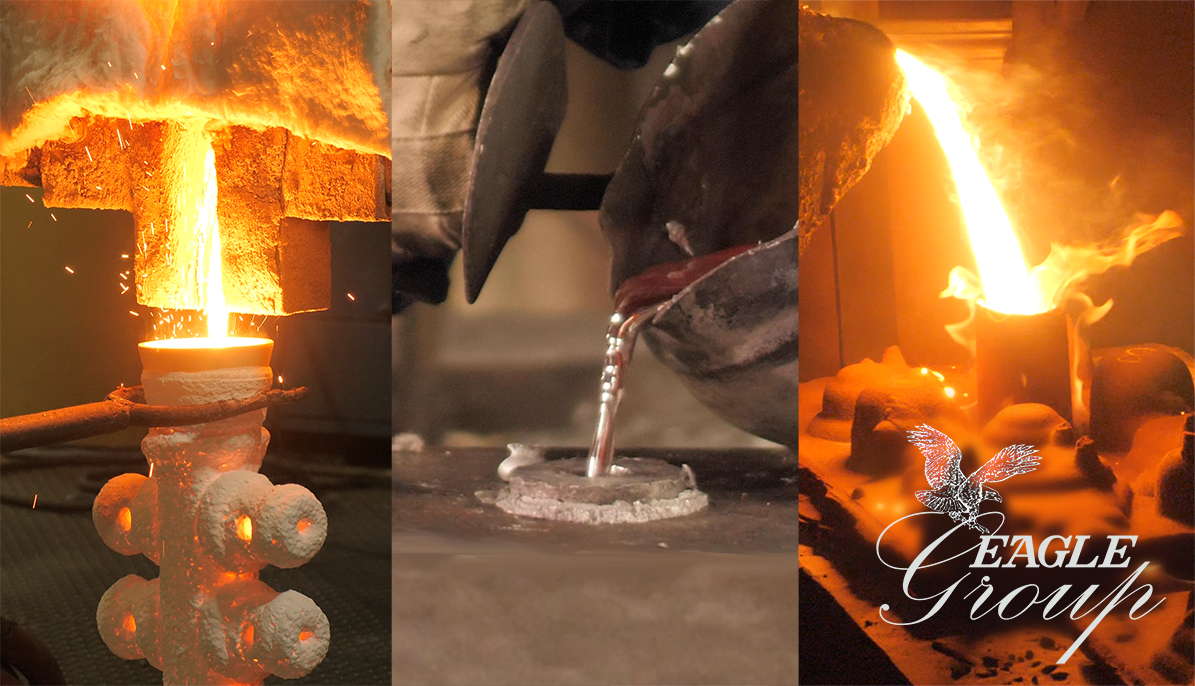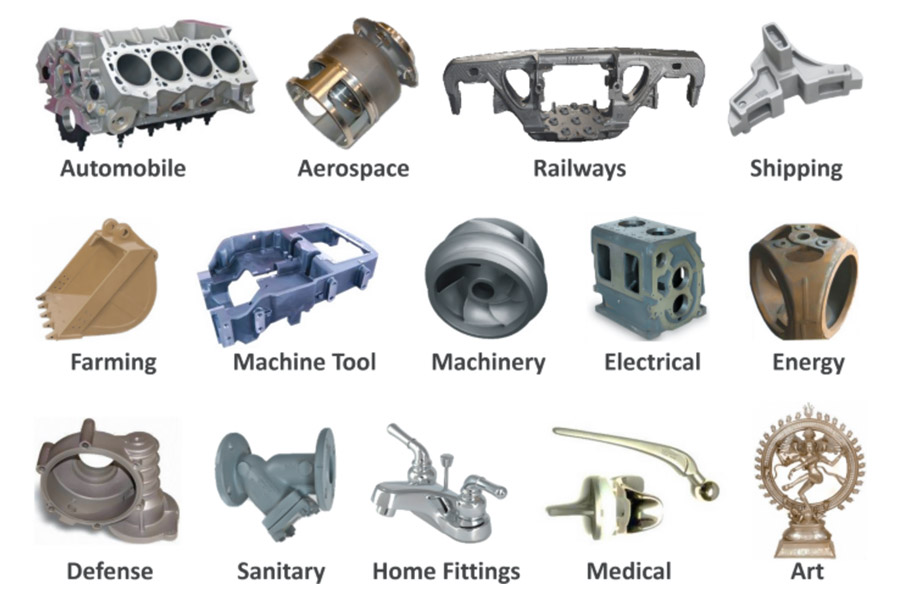Discover the versatile world of Aluminum Castings and their practical industrial applications
Wiki Article
Recognizing the Metal Castings Refine: A Comprehensive Guide for Beginners
The Metal Casting process is an essential technique in manufacturing that transforms molten steel into strong forms. Beginners should realize the numerous methods involved, such as sand casting and pass away spreading. Understanding the products, style principles, and precaution is similarly important. Each aspect plays an essential duty in accomplishing successful results. As one browses these complexities, the inquiry of how to enhance each step for boosted results comes to be significantly important.The Essentials of Steel Casting
Metal Casting has actually progressed over centuries, its basic principles stay important and regular to the production procedure. At its core, Metal Casting includes the makeover of molten steel into solid things through different methods. The process begins with the development of a mold and mildew, which defines the shape of the final product. As soon as the mold is prepared, metal is heated to its melting factor and poured into the tooth cavity. After cooling down, the metal strengthens, taking the form of the mold and mildew.There are several casting approaches, including sand casting, financial investment casting, and die casting, each with unique benefits and applications. The option of strategy relies on factors such as manufacturing volume, product type, and preferred precision. When cast, the end product may go through added procedures like machining or surface area therapy to attain the required surface and specs. Comprehending these fundamentals is important for anybody curious about the area of Metal Casting.

Recognizing Materials Used in Metal Casting
Products play a necessary role in the Metal Casting procedure, influencing the last product's residential or commercial properties and performance. Numerous metals are made use of, consisting of aluminum, bronze, steel, and iron, each offering unique characteristics fit for certain applications. Aluminum is corrosion-resistant and lightweight, making it optimal for auto components. Iron, specifically cast iron, is favored for its outstanding wear resistance and longevity. Steel supplies high toughness and flexibility, usually utilized in hefty machinery elements. Bronze, understood for its deterioration resistance and machinability, is generally used in marine applications.In enhancement to the metals, different casting products, such as sand, plaster, and ceramic, are utilized to create mold and mildews. Sand spreading, one of the most widespread technique, utilizes silica sand because of its thermal stability and ability to form detailed forms. Plaster and ceramic mold and mildews use finer details yet may require more intricate procedures. The choice of products straight influences the efficiency, cost, and high quality of the casting operation.
The Design Process: From Concept to Plan
The layout procedure in Metal Casting starts with the first idea development, where concepts are created and examined. This is complied with by the application of CAD modeling methods, enabling exact visualizations of the layout. Ultimately, the plan finalization actions ensure that all requirements are accurately recorded for production.Preliminary Concept Advancement
First principle growth notes a vital stage in the Metal Casting procedure, where ideas transform into concrete layouts. During this stage, designers collaborate with stakeholders and engineers to brainstorm and refine initial concepts. They consider elements such as functionality, aesthetic appeals, and manufacturability, making certain that the style meets the called for specs and performance standards. Illustrations and rough drafts are created to picture the ideas, enabling initial analyses of expediency and cost-effectiveness. This stage also includes recognizing materials and possible casting methods that line up with the layout objectives. Ultimately, first idea advancement prepares for a thorough plan, directing the subsequent phases of the casting process and making sure a successful shift from principle to fact.CAD Modeling Techniques
Changing concepts into accurate styles, CAD modeling strategies play a crucial role in the Metal Casting procedure. These techniques utilize innovative software application to produce comprehensive three-dimensional models that precisely show the designated item. By utilizing devices such as parametric modeling, solid modeling, and surface area modeling, developers can manipulate dimensions and forms with simplicity. CAD systems also promote simulation and analysis, enabling the identification of possible defects before production starts. This proactive technique decreases product waste and enhances the design for manufacturability. Furthermore, CAD models can be conveniently changed, allowing fast iterations based on responses. Essentially, CAD modeling works as the foundation of the design process, bridging the gap between initial principles and the ultimate production-ready layouts.Plan Completion Tips
Adhering to the production of detailed CAD versions, the following stage involves plan finalization, which is important in translating digital layouts right into actionable prepare for manufacturing. This procedure begins with assessing the CAD versions for precision and conformity with specifications. When validated, the dimensions, resistances, and material specs are diligently outlined to assure clearness. Including annotations and notes helps connect vital details concerning casting processes, surface coatings, and setting up requirements. The settled plan undergoes an extensive authorization process, usually entailing collaboration with designers and production teams to resolve any type of potential issues. After all revisions are made and authorizations gotten, the blueprint is formally launched, working as the fundamental record for the subsequent phases of Metal Casting, including pattern making and mold design.The Metal Casting Methods Discussed

Metal Casting methods encompass a range of techniques utilized to form liquified metal into desired forms. These strategies vary according to the sort of product, complexity of the style, and production volume. Sand spreading is just one of one of the most common methods, involving the creation of a mold from sand to hold the liquified steel. Investment spreading, or lost-wax casting, allows for elaborate styles by utilizing a wax pattern that is melted away. Die casting uses high-pressure injection of molten steel into a mold and mildew, appropriate for mass production. Other methods consist of irreversible mold spreading, which utilizes recyclable mold and mildews, and centrifugal casting, where rotational forces assist in filling the mold and mildew. Each strategy has its advantages and applications, making it vital for producers to pick the ideal technique based upon their specific demands and needs. Understanding these strategies is important for anyone entailed in the Metal Casting procedure.
Ending Up Processes: Enhancing Your Casted Product

Completing processes play an important function in improving the top quality and appearance of casted items. Various surface therapy techniques, such as polishing and covering, are utilized to enhance longevity and appearances. In addition, quality assessment methods ensure that the final item meets specified requirements and efficiency needs.
Surface Area Treatment Strategies
A variety of surface treatment methods play a crucial function in enhancing the high quality and durability of casted products. These techniques consist of methods such as shot blasting, polishing, and covering. Shot blasting properly removes surface area imperfections, improving the visual and functional attributes of the spreading. Sprucing up gives a smooth finish, which is especially vital for attractive applications and parts calling for very little friction. Coating techniques, such as electroplating or powder finishing, offer extra protection against deterioration and wear, ensuring longevity. In addition, surface area therapies can improve bond for subsequent procedures, such as painting or bonding. By using these methods, producers can achieve exceptional surface area top quality, which is essential for the efficiency and lifespan of Metal Casting in numerous applications.Quality Evaluation Techniques
Reliable top quality assessment techniques are vital for assuring the stability and efficiency of casted products after the completing processes. Numerous methods are used to evaluate the quality of Metal Casting, including aesthetic inspection, dimensional checks, and non-destructive testing (NDT) Aesthetic assessment enables the recognition of surface issues, while dimensional checks guarantee that products satisfy defined resistances. NDT techniques, such as ultrasonic screening and radiographic inspection, offer much deeper understandings into interior stability without damaging the castings. Additionally, mechanical screening, such as tensile and hardness tests, examines product residential or commercial properties - Metal Castings. By employing a combination of these methods, makers can boost item high quality and dependability, inevitably bring about better client complete satisfaction and minimized manufacturing pricesSecurity Considerations in Metal Casting
While the Metal Casting process supplies various benefits, it additionally provides a range of safety and security dangers that should be carefully taken care of. Employees in casting facilities are subjected to heats, molten metals, and dangerous materials, which can bring about severe injuries if appropriate safety measures are not taken. Individual safety tools (PPE) such as heat-resistant gloves, deal with guards, and protective apparel is important to decrease risks.In addition, the presence of fumes and dust requires appropriate air flow systems to ensure air quality - Aluminum Castings. Routine training on safety and security methods is important for all employees to recognize potential hazards and respond properly. Emergency situation procedures should be developed, consisting of fire precaution and initial help accessibility. Maintenance of tools and correct handling of products better add to a much safer working atmosphere. By focusing on these security considerations, Metal Casting procedures can secure their workforce and keep efficient production processes
Frequently Asked Questions
What Are the Ecological Effects of Metal Casting?
Metal Casting can bring about ecological effects such as air and water contamination, source exhaustion, and power usage. In addition, incorrect waste monitoring and emissions from factories add to ecological disruptions and health threats for neighboring areas.Exactly how Do I Pick the Right Metal for Casting?
To select the appropriate steel for spreading, one have to consider elements such as mechanical residential or commercial properties, rust resistance, thermal conductivity, and Aluminum Foundry cost. Evaluating the desired application and ecological conditions is crucial for optimal option.What Are the Typical Issues in Metal Casting?
Common defects in Metal Casting include porosity, contraction, sand incorporation, and misruns. These issues often occur from inappropriate product selection, poor layout, or problems in the casting procedure, influencing the last item's top quality and performance.
Exactly How Can I Enhance My Metal Casting Abilities?
To enhance Metal Casting skills, one must practice regularly, research casting strategies, evaluate previous projects for defects, seek responses from skilled casters, and constantly try out different materials and approaches to improve efficiency and understanding.What Is the Price of Beginning a Metal Spreading Company?
Beginning a metal spreading organization usually calls for an initial investment of $5,000 to $50,000, relying on tools, materials, and facility prices. Elements like place and range can significantly affect general startup expenditures.The Metal Casting process is a basic technique in making that transforms molten metal right into strong kinds. Beginners have to comprehend the various approaches included, such as sand casting and pass away spreading. There are several casting methods, including sand spreading, financial investment casting, and pass away spreading, each with special benefits and applications. Investment spreading, or lost-wax spreading, enables for complex designs by making use of a wax pattern that is melted away. Other approaches include long-term mold and mildew spreading, which uses multiple-use mold and mildews, and centrifugal casting, where rotational pressures assist in filling the mold and mildew.
Report this wiki page